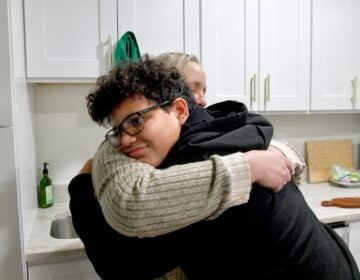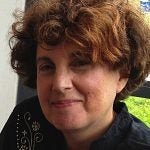The body is the focus of a Princeton Junction art show
Since recorded time, we humans have loved to depict our selves. The Venus of Willendorf, that little stone figure of a woman with a fecund belly and breasts we may remember from art history class, was created somewhere between 25,000 and 20,000 B.C. There were stick figures and other primitive figures carved into caves in Palermo in 10,000 B.C., and in the Americas, the Anasazi were carving figures into rock. The slide of the limestone bust of Nefertiti, wife of the Pharaoh who reigned during the wealthiest period of Egyptian history, also burned a lot of screen time in art history class.
The ancient Greek were the first to use perspective and foreshortening. Italian Renaissance artists became masters of anatomy to create lifelike sculptural portrayals, and Leonardo da Vinci and Michelangelo set new standards for creating the figure in art. Durer, Rembrandt and Goya went beyond the flesh to penetrate the human psyche in their portrayals.
By the 20th century, Picasso had completely deconstructed the human figure, rendering it in its geometric parts. Today, contemporary artists such as Nick Cave create “figures” from wearable fabric sculptures that perform and dance.
An exhibit at the West Windsor Arts Center looks at how Princeton area artists treat the figure. Nine Blinks: Narrating the Human Body, curated by Heather Christensen Smith, is on view through November 8 with an opening reception and artist talk on Sunday, September 14, 4-6 p.m.
Nine Blinks explores the range in which nine artists perceive and re-create the human form in their work, whether through a quick, gestural charcoal of a torso, or a detailed, photo-realistic portrait of a face, according to the curatorial statement. The artists include Janet Hautau, photography, Costanza Musumeci, collage, Hetty Baiz, human-scale forms, Paul Matthews, painting, Michelle Post, woodcut, Jonathan Shahn, drawings, Val Magarian, mixed media collage, Sally Smith, painting, and Jannick Wildberg, painting.
Although not herself an artist, Curator Smith says she’s long been interested in the relationship of an artist looking at the human form, making decisions about which part of the body to reproduce and in what medium, to what results from these decisions. “How does using clay or bronze, or focusing on an elbow or a knee, affect the outcome of the piece,” she says. “I wanted to build a show that makes the viewer think about what an artist sees, and how they choose to highlight this for the viewer.”
A few of the artists, such as Jonathan Shahn and Paul Matthews, are classically trained, but “I’m interested in how contemporary artists, whether or not working from a model, will render a hip or thigh with one quick stroke or do an incredibly detailed photorealistic portrait.”
Baiz creates the human form in two dimensions by printing the paper with her own body. Shahn creates self-referential work: an image of himself sketching an image of himself.
“Paul Matthews explores so many moments of the everyday,” Smith says. “One of most powerful is of a baby’s head crowning out of the mother, while the father is supporting her. He also paints people on the subway, or a married couple after an unsuccessful romp in the hay – he’s willing to put anything down. He shows us the raw human emotion.”
Jannick Wildberg “wants to capture the true personality of the person and uses humor, intellect, power and playfulness,” says Smith. “Eyes are of utmost importance to her.”
Janet Hautau is interested in the way water outlines the shape of the human body. “She manipulates the body, water and sun,” says Smith.
Both Val Magarian and Constanza Musumeci use collage to paint the portrait. Musumeci uses pop cultural references from fashion magazines, deconstructing the female body and creating new forms.
From Michelle Post’s oeuvre, Smith has selected a woodcut and bronze doorknocker, both of an arm and a hand. “These two pieces showcase how an artist can take the same body parts and create two completely different works of art,” says Smith.
Not being an artist, Smith has a fascination with the need of artists to produce work. “I find it beautiful that a slice of the human population just has to produce art. As a curator, I love artwork, artists, people who see artwork, and I see myself as connecting all these, with one foot in the studio and another with collectors. I want to be the liaison for artists so they can focus on painting and not be distracted by organizing exhibitions.”
Nine Blinks is on view at the West Windsor Arts Center, 952 Alexander Road, Princeton Junction, through Nov. 8. Artists talk on Sunday, Sept. 14, 4-6 p.m. Gallery hours Tuesday through Friday 10 a.m. to 6 p.m., Saturday 10 a.m. to 4 p.m. www.westwindsorarts.org
___________________________________
The Artful Blogger is written by Ilene Dube and offers a look inside the art world of the greater Princeton area. Ilene Dube is an award-winning arts writer and editor, as well as an artist, curator and activist for the arts.
WHYY is your source for fact-based, in-depth journalism and information. As a nonprofit organization, we rely on financial support from readers like you. Please give today.








